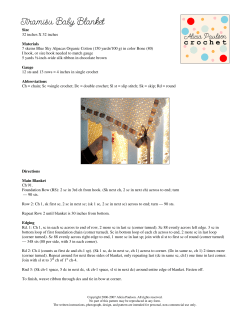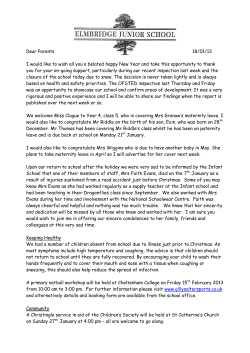
Document 156137
Flesch-Kincaid Grade Level: 8.9 Flesch-Kincaid Reading Ease: 57.0 Drawspace Curriculum 6.1.A7 - 4 Pages and 9 Illustrations Draw a Realistic Eye Outline various parts of an eye, draw natural-looking eyelashes, and add shading to create a lifelike representation of an eye Resource: Module 3.1 Introduction to Shading Supplies: paper, 2H, HB, 2B, and 4B pencils, 6B, 7B, or 8B pencil, pencil sharpener, sandpaper block, kneaded and vinyl erasers, pencil sharpener This tutorial has four sections: • Conduct an Eye Examination • Sketch the Shapes of an Eye • Draw an Eyeful of Eyelashes • Shade a Realistic Eye As an Aside Eyes and mouths are the most expressive facial features. The shapes and sizes of people’s eyes can even indicate their gender, age, and cultural origin. In a portrait, the eyes alone can often identify who the person is. ArtSpeak Contrast: The juxtaposition of different values. Contrast is an invaluable tool for accentuating various components of composition. Eyelashes: Fine hairs that grow from the outer edges of the upper and lower eyelids. Form: An element of art that is created in drawings and paintings by using shading and/or colors to transform shapes into three-dimensional structures. Graduation: (also called gradation, graduated shading or graduated values) A continuous, seamless progression of values from dark to light or light to dark. Highlight: A small section of a drawing subject that is rendered with white or a very light value to identify the brightest area where light bounces off its surface. Highlights are more pronounced on shiny or glistening surfaces than dull or matte surfaces. Inner corner of an eye: A small, reddish, triangular or oval-shaped form in the inside corner of the eye close to the nose. Iris: The colored circular section of an eyeball surrounding the pupil. Lower eyelid: The fold of skin that protects the lower section of the eyeball. The lower eyelid cannot move without help from facial muscles around the eye. ISBN: 978-1-77193-008-6 Copyright © 2013 Drawspace Publishing and Brenda Hoddinott. All rights reserved. No part of this publication may be reproduced, stored in a retrieval system, transferred, or transmitted in any form or by any means, including electronic, digital, mechanical, recording, photographing, photocopying, or otherwise, without the purchase of a licence from drawspace.com or the prior written consent of Brenda Hoddinott and Drawspace Publishing. 2 Drawspace Curriculum 6.1.A7 ArtSpeak Tip! Pupil of an eye: The dark circular shape within the iris that dilates and constricts under different lighting conditions. To learn how to draw naturallooking eyelashes, refer to 6.1.A6 Draw Realistic Eyelashes. Conduct an Eye Examination 1. Refer to Figure 1 and identify each of the following parts of an eye: • inner corner (1) • upper eyelid (2) Upper eyelid: A fold of skin that opens and closes automatically (blinks) to protect the eyeball. • highlight (3) As an Aside White of the eye: The large visible section of an eyeball that is light in value and color but is not really white. In the actual sketch, the lines are very faint. The sketch lines in the next section have been darkened in Photoshop so you can see them clearly. • outer corner (4) • white of the eye (5) • iris (6) • pupil (7) • lower eyelid (8) • eyelashes (9) Figure 1 Sketch the Shapes of an Eye 2. Lightly sketch the eye shown in Figure 2. The double line at the top and bottom represents the thickness of the flesh of the upper and lower eyelids. Figure 2 Don’t forget to add the shape of the inner corner of the eye. If your sketch ends up too dark, gently pat the lines with a kneaded eraser before you continue to the next section. ISBN: 978-1-77193-008-6 Copyright © 2013 Drawspace Publishing and Brenda Hoddinott. All rights reserved. No part of this publication may be reproduced, stored in a retrieval system, transferred, or transmitted in any form or by any means, including electronic, digital, mechanical, recording, photographing, photocopying, or otherwise, without the purchase of a licence from drawspace.com or the prior written consent of Brenda Hoddinott and Drawspace Publishing. Drawspace Curriculum 6.1.A7 Draw an Eyeful of Eyelashes Figure 3 3. Use sharpened 2H and HB pencils to draw a few eyelashes on the outer edges of the upper and lower eyelids. Figure 3 shows eyelashes that are sparse and short. 4. Use a sharpened 2B pencil to add a few darker lashes of various lengths toward the outer corner of the eye for thicker eyelashes. Figure 4 Most people have an average smattering of eyelashes, as shown in Figure 4. 5. Use a 2B pencil to add a few thicker eyelashes. The eyelashes in Figure 5 appear to be very thick. Figure 5 6. Outline an iris, pupil, and highlights. The light source originates from the upper frontal left (Figure 6). As an Aside Figure 6 You can indicate the color of the iris of an eye by using different values: • Brown eyes are very dark in value; almost as dark as the pupil. • Hazel, blue, or green eyes are mostly shaded with middle values. • Pale blue, green, or gray eyes are very light in value and contrast sharply to the dark pupil. ISBN: 978-1-77193-008-6 Copyright © 2013 Drawspace Publishing and Brenda Hoddinott. All rights reserved. No part of this publication may be reproduced, stored in a retrieval system, transferred, or transmitted in any form or by any means, including electronic, digital, mechanical, recording, photographing, photocopying, or otherwise, without the purchase of a licence from drawspace.com or the prior written consent of Brenda Hoddinott and Drawspace Publishing. 3 4 Drawspace Curriculum 6.1.A7 Shade a Realistic Eye Figure 7 7. Add graduated shading to the iris and pupil (Figure 7). Use 2B and 4B pencils to shade the iris and a 6B, 7B, or 8B for the pupil. The iris is darker around its perimeter and under the upper eyelid (which is in shadow). A few tiny lines radiate outward from the pupil and the highlights on the shiny surface of the eye are left white. 8. Add shading to the whites of the eye, the edges of the upper and lower eyelids, and the inner corner (Figure 8). Figure 8 9. Add some thin lines extending onto the whites from the inner corner to look like tiny blood vessels. As an Aside The eyelashes of some individuals may appear unnaturally thick, dark, and long thanks to false eyelashes or eye makeup such as mascara. Figure 9 Challenge! Draw this person’s right eye (Figure 9). If you were looking at his or her face front on, this eye would be on your left. ISBN: 978-1-77193-008-6 Copyright © 2013 Drawspace Publishing and Brenda Hoddinott. All rights reserved. No part of this publication may be reproduced, stored in a retrieval system, transferred, or transmitted in any form or by any means, including electronic, digital, mechanical, recording, photographing, photocopying, or otherwise, without the purchase of a licence from drawspace.com or the prior written consent of Brenda Hoddinott and Drawspace Publishing.
© Copyright 2025














